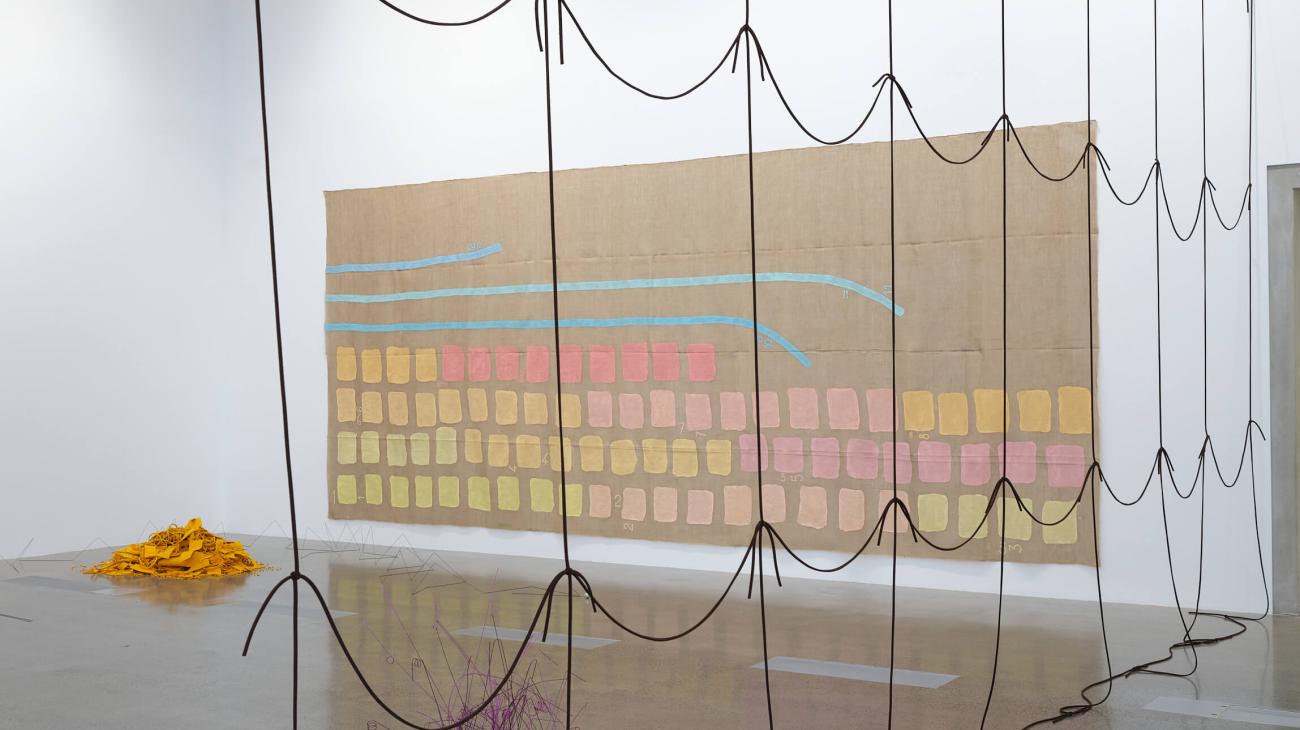
Giorgio Griffa & Peter Robinson: Differences in Kind and Rhythm, 2025—Te Uru Contemporary Gallery, New Zeland. Photo by: Sam Hartnett. Courtesy Te Uru.

Giorgio Griffa & Peter Robinson: Differences in Kind and Rhythm, 2025—Te Uru Contemporary Gallery, New Zeland. Photo by: Sam Hartnett. Courtesy Te Uru.
The dialogue exhibition Differences in kind and rhythm, featuring Italian painter Giorgio Griffa and New Zealand sculptor Peter Robinson (Ngāi Tahu, 1966), is curated by James Gatt and organised by Te Uru Waitākere Contemporary Gallery in Aotearoa New Zealand. The exhibition is part of an ongoing series that pairs artists from Aotearoa and the international scene.
Spanning the years 1972 to 2025, the works on display—paintings on canvas by Griffa and sculptures by Robinson—unfold across time and across practices. Although from different generations and cultural contexts, the two artists share a systematic use of repeat forms and processes to explore notions of difference, variation, transformation, and continuity. Through gestures such as marking, stacking, and folding—each echoing broader reflection on time, matter, and identity—they construct modular or sequential compositions that serve as visual mappings of their own open-ended creative processes.
A carefully conceived installation generates vibrant and shifting relationships between Robinson’s sculptures and Griffa’s canvases, activating the shared exhibition spaces in a fluid and resonant interplay. Alongside this inquiry into process and form, the exhibition offers a field of cross-cutting references—from science to number, ancestral traditions to philosophy—drawing together two culturally and geographically distant perspectives: the Western and the Māori. What emerges is a profoundly generative encounter.
The exhibition is accompanied by a fully illustrated catalogue (forthcoming July 26th), featuring new texts by Christina Barton, Jarrett Earnest, Justin Paton, and Shannon Te Ao, as well as an extended curatorial essay by James Gatt.
To what extent can any two things be considered the same? And what is generated by their non-sameness? These are the questions that galvanised and absorbed me in connecting the practices of Giorgio Griffa and Peter Robinson for Differences in kind and rhythm.
Collectively, exhibited paintings by Griffa and sculptures by Robinson span a period from 1972 to 2025. These works share primarily in their sequencing of repeat processes and forms. Through repetitive gestures such as line making, stacking, and folding, the artists create sequential or modular compositions that visually map their own becoming. As we trace these sequences, we are looped into a process of emergence. Each addition to a sequence changes the very sequence it occupies—a process of repetition towards difference. Across exhibited works we find patterns of signs and digits (lines, dashes, numerals) and sequent build- ups of objects (such as lengths of wire, aluminium cubes or die-cut felt pieces). Although we encounter them as fixed compositions on canvas or in space, they compel us to imagine how their sequences might change, holding us in what feels like a temporary or dormant state between the past (the material traces we see) and future (their pending evolution). These sequences operate like emergent systems—networks in which individual components are understood and informed by their grouping or collaboration. This gives exhibited paintings and sculptures a sense of animation, evolution, or even sociality. What we perceive as near-automatic systems of composition are in fact open-ended processes alive with possibilities for variation and potentially endless unfolding.
Traversing three rooms, Differences in kind and rhythm proceeds from simpler, sparer uses of lines to more complex, lyrical, and colourful networks of basic geometries and, finally, on to numerical sequences and spiral forms with more overt reference points. These passages were developed from three key links between the practices of Griffa and Robinson: repetition, folding, and becoming (what we might call ‘the possibility of possibility’), forming subtle, overlapping exhibition chapters. The exhibition also operates along the slippery line between painting and sculpture, with only paintings from Griffa and only sculptures from Robinson, forming an installation in which two- and three-dimensional compositions interact, animating the shared space between them.
James Gatt